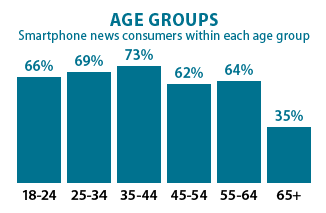News content consumption has changed drastically, and not just among digital natives. It makes sense to peg Gen Yers and Millennials as the driving force behind the fundamental shift in how brands distribute messages and consumers receive them, but data tells a different story. The “2013 Q1 Research Report” from the Donald W. Reynolds Journalism Institute (RUI) at the University of Missouri indicates Gen X members – people between the ages of 35 and 44 – have most readily embraced mobile devices as a vessel for news. Seventy-three percent check for updates on their smartphones.
Marketers cannot ignore the fact that all demographics are turning to the web for updates, information and entertainment. It’s not enough to share branded content intended for younger audiences on the web and reserve campaigns geared toward older age groups for traditional channels.
Millennials are consuming news on the ‘net via mobile devices, but so are their parents. Two-thirds of 18-to-24-year-olds and 64 percent of people between the ages of 55 and 64 browse headlines on their mobile devices. Even 35 percent of consumers 65 and older read news this way, the study found.

Marketers might assume it’s difficult to reach these readers without first building a separate mobile platform, but it may only require strategic social media content. The news consumption trend mirrors those of Twitter adoption. Brafton recently reported the network has attracted members across age demographics, and these users are often checking for real-time news updates on desktops, tablets and smartphones.
Brands that regularly share timely news stories on the social channels where their customers are most active – be it Facebook, Twitter, LinkedIn or Reddit – can keep their marketing messages in front of readers’ eyes.





